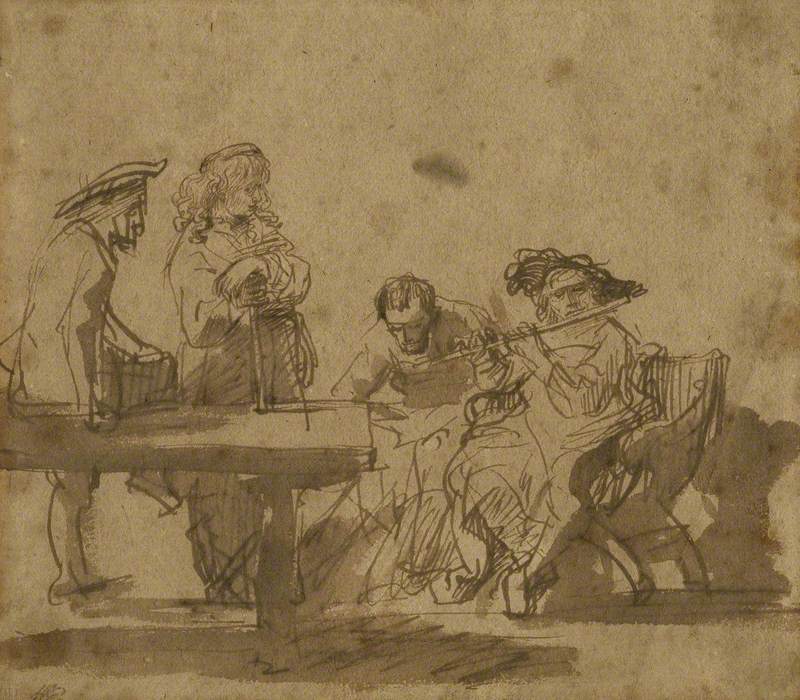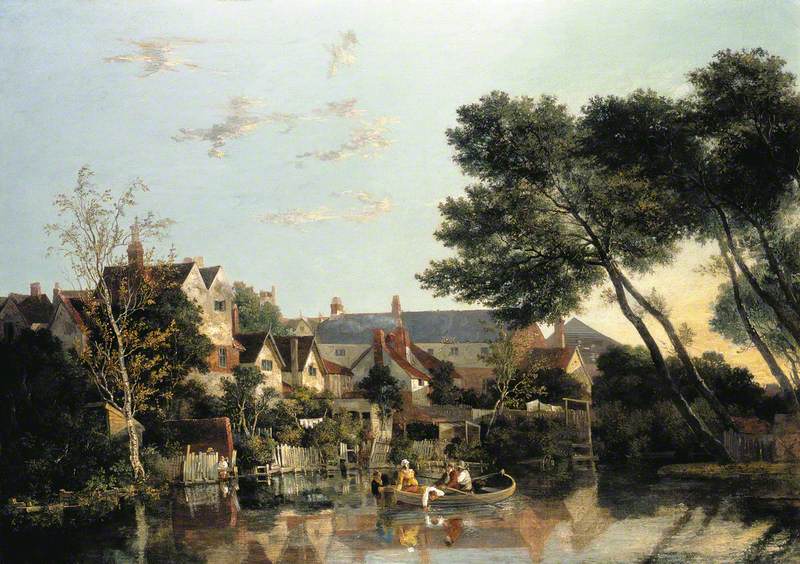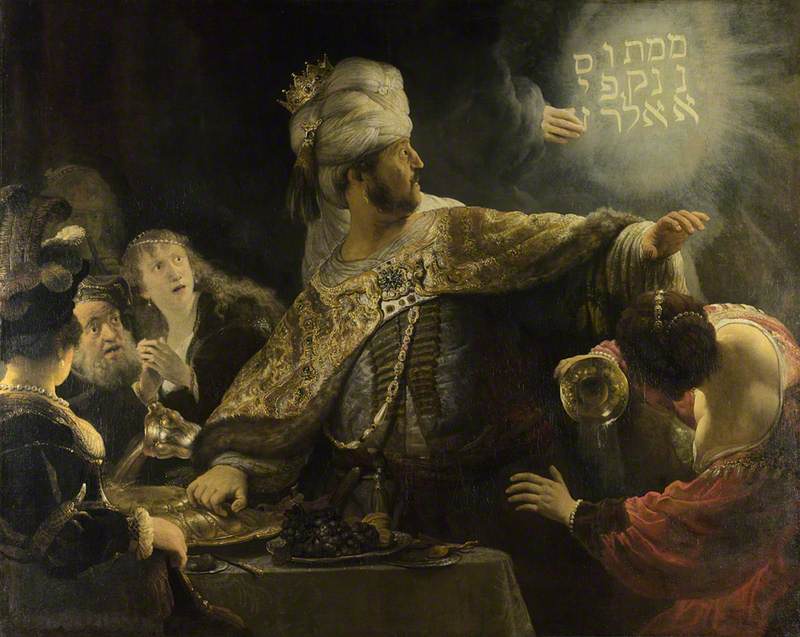The fine art collection at Norwich Castle comprises approximately 1,200 oil paintings, 10,000 watercolours and drawings, and 8,500 prints. It contains the world’s finest collection of works by the Norwich School of Artists, and the Dutch and Flemish landscape painters who inspired them. The modern and contemporary collection is broader in focus, with a small but significant number of international twentieth-century paintings.
Art Unlocked is an online talk series by Art UK in collaboration with Bloomberg Philanthropies. This Curation is based on a talk by Dr Francesca Vanke, Keeper of Art & Senior Curator at the Norwich Castle Museum and Art Gallery, on 10th November 2021. You can find a recording at: https://youtu.be/32XAUqO-3Bs
-
Group of Musicians Listening to a Flute Player 1635
Norwich Castle holds 93 of Rembrandt’s etchings, the fourth largest collection in the UK, and this one drawing. It demonstrates Rembrandt’s unique ability to sum up a scene in a few perfectly placed lines and washes. Here, on the lower right of the figures, deceptively simple patches of wash show that the light comes from top left. Careful squiggles indicate the flautist’s hands and body, though his face and hat are more detailed. A few pen strokes capture his chair. The man to the left is listening with bowed head. Next is a more detailed figure with luxuriant curls. Finally the man at far left is so schematically represented that a thick ink comma is all Rembrandt used to sketch a closed eye and suggest an air of rapt concentration.
Rembrandt van Rijn (1606–1669)
Pen and brown ink, brush and brown wash on paper
Norfolk Museums Service
-
The Paston Treasure c.1665
This artwork defies easy interpretation. It is a type of ‘vanitas’ still-life: reminders of time and death contrast with gold symbolising worldly wealth. The gilded cups were real, part of a huge collection belonging to the Norfolk Paston family.
It once included three people, but one, a lady in red, was painted out. The girl is most likely Margaret Paston, whose grandfather William probably commissioned the painting. He may possibly also have purchased the young African man, as an enslaved servant.
The Pastons went bankrupt in the 1700s. This painting, and a gilded shell cup, given to Norwich Castle, are among the last few known items from their collection. These works survive as an eloquent memorial to the Pastons’ lost world.
Dutch School
Oil on canvas
H 165 x W 246.5 cm
Norfolk Museums Service
-
Walton Bridges 1806
This was painted during one of Turner's many trips on the Thames. Made from direct observation, it exemplifies Turner's artistic concerns early in his career. It also ties in closely with the aims of the Norwich School artists: to experience the landscape in depth.
This intense focus on nature chimed with contemporary Romanticism, which glorified emotional responses to the natural world, especially its most spectacular aspects, whether these were purely enjoyable like sunsets, or had a frightening, dangerous side, like avalanches or storms.
Turner portrayed nature's timeless beauty, but balanced this with scenes of everyday life and modern commerce. He engaged fully with both the sublime and the mundane, showing them in coexistence.
Joseph Mallord William Turner (1775–1851)
Oil on canvas
H 92.7 x W 123.8 cm
Norfolk Museums Service
-
Norwich River: Afternoon c.1812–1819
This most memorable work by John Crome was probably painted in the summer of 1818. Its soft light and warm colours suggest an idyllic, peaceful landscape. However, Crome’s work was always grounded in real life. At the time, this area of Norwich riverside housed small cul-de-sacs containing cramped, unsanitary workers’ cottages.
The large louvred gable visible in the background looks like a drying loft, possibly for the nearby tannery. Crome’s audiences would have recognised the location and been familiar with the poverty endured by local weavers, dyers and tanners.
Crome was not necessarily making a pointed social comment. He was probably aiming to portray the reality of his local environment in all its aspects, both beautiful and harsh.
John Crome (1768–1821)
Oil on canvas
H 71 x W 99.5 cm
Norfolk Museums Service
-
Heron in the Shallows 2013
Herons are Maggi Hambling’s favourite birds. She has painted them many times, perfectly capturing their streamlined speed and grace. However, this heron is anchored in earth, a desolate earth which seems scarce distinguishable from the water. This picture is a sharp comment on the effect of polluted habitats on wildlife. The sky is a flat, featureless white with none of the usual life and movement. The bird itself is the only life portrayed, and, while it comes over as strong and vibrant, with its flashes of intensely blue feathers and fiercely bright gold eye, it is struggling. The beauty of this heron can momentarily distract us from its grim situation: it has picked up a mouthful of sewage and is searching in vain for fish.
Maggi Hambling (b.1945)
Oil on canvas
Norfolk Museums Service
 © the artist / Bridgeman Images. Image credit: Norfolk Museums Service
© the artist / Bridgeman Images. Image credit: Norfolk Museums Service
-
Susan, Aarti, Keerthana and Princess, Sunday in Brooklyn 2018
This work depicts a two-mother, mixed-race family whose collective heritage is Indian and African-American. They are a family that came together through immigration, adoption, and New York City and are deeply committed to social justice and racial equity – both women have devoted their careers to advancing education and human rights.
Aliza Nisenbaum is a Mexican-born artist based in New York. She is best known for her painted portraits of undocumented immigrants from Mexico and Central America. Her deeply observed paintings are part of a socially engaged practice that challenges the social and representational hierarchies of traditional portraiture. For
Nisenbaum, her subjects are not merely sitters but active collaborators.
Aliza Nisenbaum (b.1977)
Oil on linen
Norfolk Museums Service








